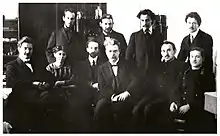Nikolai Konstantinovich Koltsov | |
|---|---|
 | |
| Born | July 14, 1872 |
| Died | December 2, 1940 (aged 68) |
| Nationality | Russian |
| Alma mater | Moscow University |
| Scientific career | |
| Fields | Genetics Molecular biology |
| Notable students | Nikolay Timofeeff-Ressovsky Vladimir Pavlovich Efroimson Aleksandr Promptov Alexander Sergeevich Serebrovsky |
Nikolai Konstantinovich Koltsov[1] (Russian: Николай Константинович Кольцов; July 14, 1872 – December 2, 1940) was a Russian biologist and a pioneer of modern genetics. Among his students were Nikolay Timofeeff-Ressovsky, Vladimir Pavlovich Efroimson, A.S. Serebrovsky, and Nikolay Dubinin. Along with his students, he demonstrated the fine structure of genes, and examined the structure of the cell and pioneered the idea of a cytoskeleton. His career was cut short in Stalinist Russia after being falsely accused of supporting scientific racism. He died unexpectedly following government persecution and there are allegations that he was executed.
Biography

Koltsov was born in a well-to do family, his father was an accountant in a fur company, and graduated from Moscow University in 1894 and was a professor there (1895–1911). He established and directed the Institute of Experimental Biology in the middle of 1917, just before the October Revolution. He was a member of the Agricultural Academy (VASKhNIL). He was against the Tsarist regime but after the revolution, he opposed several policies of the new rule. In 1911 he left Moscow University and moved to the Shanyavsky Moscow City People's University. In 1920, Koltsov was arrested as a member of the non-existent "anti-Soviet Tactical Center" invented by the VCheKa. Prosecutor Nikolai Krylenko demanded the death sentence for Koltsov (67 of around 1000 arrested people were executed).[2] However, after a personal appeal to Vladimir Lenin by Maxim Gorky Koltsov was released and was restored to his position as the head of the Koltsov Institute of Experimental Biology.[3]

The politics of the Soviet Union made the idea of genes, particles that decided outcomes in life, as antithetical to the concept of individual freedom. Marxist ideologues also clubbed geneticists with eugenicists, racists, and fascists while also preferring ideas from Lamarckism as promoted by Trofim Lysenko.
In 1937 and 1939, the supporters of Lysenko published a series of propaganda articles against Nikolai Koltsov and Nikolai Vavilov. They wrote: "The Institute of Genetics of the Academy of Sciences not only did not criticize Professor Koltsov's fascistic nonsense, but even did not dissociate itself from his "theories" which support the racial theories of fascists".[2] His death in 1940 was claimed to have been due to a stroke. However, "the biochemist Ilya Zbarsky revealed that the unexpected death of Koltsov was a result of his poisoning by the NKVD", the secret police of the Soviet Union.[4] On the same day his wife, the scientist Maria Sadovnikova Koltsova, committed suicide.[2][5]
Research
Nikolai Koltsov worked on cytology and vertebrate anatomy. In 1903 Koltsov proposed that the shape of cells was determined by a network of tubules forming a skeleton[6] which was later termed as the cytoskeleton. He saw the role of gel-sol transitions in the cytoplasm as key mechanisms for the cell structure.[7] In 1927 Koltsov proposed that inherited traits would be inherited via a "giant hereditary molecule" which would be made up of "two mirror strands that would replicate in a semi-conservative fashion using each strand as a template".[3] Koltsov used the expression omnis molecula ex molecula (every molecule comes from another molecule) based on Virchow's idea that all cells came from other cells. These ideas were confirmed to have been accurate in 1953 when James D. Watson and Francis Crick described the structure of DNA. Watson and Crick had apparently not heard of Koltsov. US geneticist Richard Goldschmidt wrote about him: "There was the brilliant Nikolai Koltsov, probably the best Russian zoologist of the last generation, an enviable, unbelievably cultured, clear-thinking scholar, admired by everybody who knew him".[3] He also suggested that electrical forces were involved in intracellular movement. He termed it as cataphoresis.[8]
Legacy
Koltsovo, a small municipality in Novosibirsk Oblast, in 2003 obtained the status of the Science town of the Russian Federation and was named after Nikolai Koltsov.[9]
References
- ↑ He used the spelling Koltzoff in his publications.
- 1 2 3 Vadim J. Birstein. The Perversion Of Knowledge: The True Story of Soviet Science. Westview Press (2004) ISBN 0-8133-4280-5
- 1 2 3 Soyfer, Valery N. (1 September 2001). "The consequences of political dictatorship for Russian science". Nature Reviews Genetics. 2 (9): 723–729. doi:10.1038/35088598. PMID 11533721. S2CID 46277758 – via www.nature.com.
- ↑ Soyfer, Valery N. (2001). "The consequences of political dictatorship for Russian science". Nature Reviews Genetics. 2 (9): 723–729. doi:10.1038/35088598. ISSN 1471-0056. PMID 11533721. S2CID 46277758.
- ↑ Boronix, D. N. (1941). "Dr. Nikolai K. Koltzoff". Journal of Heredity. 32 (10): 347–350. doi:10.1093/oxfordjournals.jhered.a104961. ISSN 1465-7333.
- ↑ Koltzoff, Nic. (1924). "Experimental biology and the work of the Moscow Institute". Science. 59 (1536): 497–502. Bibcode:1924Sci....59..497K. doi:10.1126/science.59.1536.497. ISSN 0036-8075. PMID 17775910.
- ↑ Morange, Michel (2011). "The attempt of Nikolai Koltzoff (Koltsov) to link genetics, embryology and physical chemistry". Journal of Biosciences. 36 (2): 211–214. doi:10.1007/s12038-011-9075-4. ISSN 0250-5991. PMID 21654074. S2CID 36718177.
- ↑ Koltzoff, N. K.; Schröder, V. N. (1933). "Artificial Control of Sex in the Progeny of Mammals". Nature. 131 (3305): 329. Bibcode:1933Natur.131..329K. doi:10.1038/131329a0. ISSN 0028-0836.
- ↑ "Наукоград". kolcovo.ru.